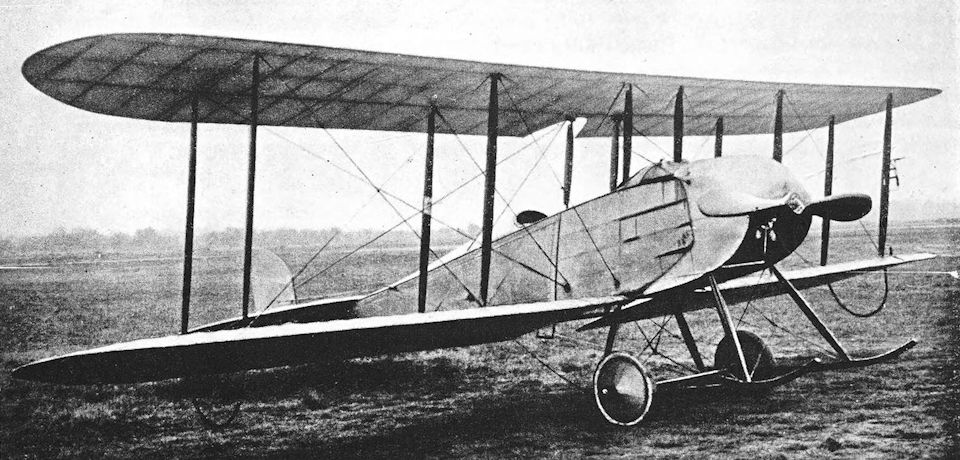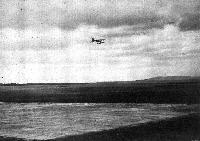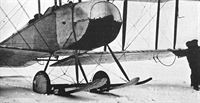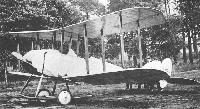P.Hare Royal Aircraft Factory (Putnam)
B.E.8
The rotary-engined B.E.8 was designed by John Kenworthy. It broadly followed the layout of his previous designs, the B.E.3 and B.E.4, but its lower wings were attached directly to the fuselage, without the gap of the earlier designs, and the tail surfaces were modelled upon those of the original B.E.2. In common with most of its contemporary stablemates, the B.E.8 had wing-warping for lateral control and undercarriage skids to protect the propeller tips during landing.
The prototype, which was powered by a 70hp Gnome and had no division between the cockpits, made its first flight on 20 August 1913. It was followed by a second example which had obviously been built concurrently, as it flew less than three weeks later, on 8 September.
The type was apparently thought to present a viable alternative to the B.E.2, and was adopted for limited production by Vickers, which built eleven, the Coventry Ordnance Works (seven), and the Bristol based British and Colonial Aeroplane Company (six), the initial order being placed with the last-named company a few days before the prototype first flew. Production examples differed from the prototypes in having a decking between the cockpits and a triangular fin identical to that later adopted for the B.E.2c. They were powered by 80hp Gnome rotary engines driving four-bladed propellers. The two prototypes were later converted to production standard and transferred to the RFC, in whose service they bore the serials 423 and 424.
The first production machine, 365, was delivered for inspection on 10 March 1914 and was retained at the Royal Aircraft Factory. Records indicate that it was eventually tested to destruction.
Nicknamed The Bloater, the B.E.8 served in small numbers with Nos 1, 3, 5, 6 and 7 squadrons of the RFC and at the Central Flying School, and two examples found their way to India. The type saw service on the Western Front in the early days of the war, but was regarded as being somewhat underpowered. Unfortunately it proved to be rather prone to spinning, and as that manoeuvre and the recovery from it were far from universally understood, several machines were lost in crashes. On 18 August 1914 391 crashed at Peronne, killing its observer and badly injuring the pilot, Lt R Smith-Barry. He eventually recovered, although he needed to walk with a stick for the rest of his life, and in 1917 founded and commanded the School of Special Flying at Gosport, in Hampshire.
The B.E.8 s fuel system appears to have been a source of annoyance and the subject of criticism since, if the need arose to repressurise the tank manually, the hand pump was in the observer's cockpit and the pressure gauge was in the pilot's. Difficulty in communication could result in fuel overflowing, with the obvious fire risk. Although there is no evidence of such a fire actually occurring, the problem clearly reduced the crews' confidence in their mounts.
In January 1915 an attempt was made to improve the B.E.8's performance by the substitution of a 100hp Monosoupape for the 80hp engine. The conversion was made to 658 but, while it had the desired effect, the 'Mono' was relatively scarce, those available being needed for more potent aeroplanes, so no service B.E.8s were ever thus powered. So, underpowered, yet denied the proven remedy, the remaining B.E.8s had all been withdrawn from front-line service by mid 1915, and finished their careers with training units.
Powerplant: 80hp Gnome rotary
Dimensions:
span 37ft 8in;
chord 5ft 6in;
gap 6ft 0in;
wing area 368 sq ft;
length 27ft 4 1/2in;
height 9ft 4in.
Performance:
max speed 70mph at sea level;
climb 10 1/2min to 3,000ft;
endurance 1 1/2hrs.
B.E.8a
Making its debut early in 1915, the B.E.8a used the wings and horizontal tail surfaces of the B.E.2c, thereby having ailerons instead of the warping of the earlier model.
No prototype was produced. Instead, as soon as the drawings were completed, production orders for twenty-one machines each were placed with Vickers and the Coventry Ordnance Works. The 80hp Gnome, as used in the B.E.8, remained the standard engine, although a few machines were fitted with the Clerget 7Z of similar power.
One example was used to test the experimental 120hp R.A.F.2 radial engine, and another had its undercarriage modified to incorporate skis affixed to the axle inboard of the wheels, but neither installation was adopted for production machines.
With a perception that was all too rare at that stage in the war, the RFC never regarded the B.E.8a as an operational machine, and the majority served with reserve squadrons and other training units in the UK. It seems to have shared the earlier version's reputation for being easy to spin, and as result a number were fitted in service with the larger fin, with its distinctive curved leading edge, which was the standard fitment for the B.E.2e.
Powerplant:
80hp Gnome rotary
80hp Clerget 7Z
Dimensions:
span 37ft 8 1/2in;
chord 5ft 6in;
gap 6ft 3in;
wing area 368sqft;
length 27ft 4 1/2in;
height 10ft 3 1/2in.
Performance:
max speed 75mph at sea level;
F.Manson British Bomber Since 1914 (Putnam)
Royal Aircraft Factory B.E.8
The Royal Aircraft Factory's B.E.8 was a rotary-engined derivative of the B.E.2, and probably flew in prototype form early in 1913. Powered by the 80hp Gnome engine, it differed from the contemporary B.E.2 in possessing heavily staggered wings, although early production examples retained wing-warping, and the prototype had no fin. The fuselage was somewhat deeper than that of the B.E.2 in order to accommodate the engine within the nose contours, the rounded nose cowling being open in the lower segment to assist engine cooling.
As limited production got underway in 1914 a small triangular fin was added and fuselage top decking was fitted between the cockpits; the undercarriage was of the twin wheel-and-skid type, and most aircraft were fitted with four-blade propellers.
On the outbreak of war a single B.E.8 accompanied No 3 Squadron to France on 13 August 1914 but suffered a fatal crash three days later. Half a dozen further B.E.8s (known as 'Bloaters' in the RFC on account of their bulbous noses) were issued to Squadrons in France by the end of the year and, like the B.E.2s, began bombing attacks in March 1915. Four aircraft of No 1 Squadron, flown by Capt Edgar Rainey Ludlow-Hewitt (later Air Chief Marshal Sir Edgar, KCB, CMG, DSO, MC, RAF), Lieut Eustace Osborne Grenfell (later Gp Capt, vie, DFC, AFC, RAF), Lieut Oswald Mansell Moullin and Lieut V A Barrington-Kennett, bombed railway targets at Douai on the 12th.
The B.E.8A, of which 42 were built by Vickers and the Coventry Ordnance Works, also powered by the 80hp Gnome, introduced wings similar to those of the B.E.2C with double-acting ailerons on upper and lower surfaces; later aircraft also featured the B.E.2C's tail unit with enlarged fin. One experimental B.E.8A was tested with the 120hp R.A.F.2 nine-cylinder radial engine.
Type: Single-engine, two-seat, two-bay biplane field reconnaissance aircraft, later flown in the light tactical bombing role.
Manufacturers: The Royal Aircraft Factory, Farnborough, Hants. B.E.8. The British & Colonial Aeroplane Co Ltd, Filton, Bristol; Vickers Ltd (Aviation Department), Knightsbridge, London SW. B.E.8A. The Coventry Ordnance Works Ltd, Coventry.
Powerplant: 80hp Gnome air-cooled rotary engine. Experimental. 120hp R.A.F.2.
Dimensions: Span, 39ft 6in (B.E.8A, 37ft 8 1/2in); length, 27ft 3in.
Performance: B.E.8. Max speed, 70 mph at sea level; climb to 3,000ft, 10 min 30 sec.
Armament: No standard gun installation. One 100 lb bomb could be carried.
Prototype: Prototype was probably No. 365.
Production: Completion of at least 27 B.E.8s (between No 373 and 740) has been confirmed, and 42 B.E.8As, Nos 2133-2174.
Summary of Service: Small numbers of B.E.Ss and 8As served with Nos 1, 2, 3, 5, 6 and 9 Squadrons, RFC in France between September 1914 and November 1915. First used as a bomber in March 1915. B.E.Ss and 8As were flown at the Central Flying School, Upavon, and one B.E.8 was flown by No 3 Flight, RNAS, Westgate, in July 1915.
P.Lewis British Bomber since 1914 (Putnam)
Another of the early Royal Aircraft Factory designs which found itself adapted as a bomber soon after the start of the war was the B.E.8, a well-proportioned two-seat, two-bay, equal-span biplane with 39 ft. 6 in. staggered wings and the 80 h.p. Gnome as its engine. The first prototype was started during 1912, but the Factory built three examples only of the design, the ensuing fairly small production run being undertaken by Bristol, Coventry Ordnance Works and Vickers to contracts placed in 1914. Last of the Factory’s B.E. designation to employ the rotary style of power plant, the B.E.8 sported a rounded cowling over the upper portion of the unit. The three prototypes were turned out without a fin, but this was added to the tail units of the production models. These also were given ailerons on the upper wings in place of the prototypes’ all-warping system. In common with the majority of the early machines adapted as vicarious bombers in the first few months of the conflict, the B.E.8 was flown solo when loaded with its single 100 lb. missile, and this was the case when four ‘Bloaters’ from No. 1 Squadron, R.F.C., launched their attack against the railway bridge at Douai on 12th March, 1915.
O.Thetford British Naval Aircraft since 1912 (Putnam)
B.E.8
Commonly known as 'The Bloater', the B.E.8 was used from 1912 as a trainer at the Central Flying School and one example was still servIng WIth No.3 Flight, RNAS Westgate, in July 1915. One 80 hp Gnome engIne. Maximum speed, 70 mph at sea level. Climb, 10 1/2 min to 3.000 ft. Span, 39 ft 6 in. Length, 27 ft 3 in.
H.King Armament of British Aircraft (Putnam)
B.E.8 and 8a. A single 100-lb bomb could be carried by aircraft of this type and it is likely that the usual small arms, though not machine-guns, were also taken into the air.
M.Goodall, A.Tagg British Aircraft before the Great War (Schiffer)
Deleted by request of (c)Schiffer Publishing
BE.8 biplane
Kenworthy was responsible for the development of the BE.3/4 type into the BE.8, a similar rotary-powered tractor biplane, which was first flown in August 1913. Two prototypes were built at the RAF, and were probably the machines delivered to the CFS, Nos.423-424 in November 1913. Subsequent machines were manufactured by Vickers, Bristols and the Coventry Ordnance Works, to a total of twenty four.
The main changes from the BE.3/4 included mounting the lower wings directly to the fuselage bottom longerons, and the fitting of a BE.2 type rudder. The two prototypes had one large cockpit for the two occupants, but production aircraft incorporated a central decking, a triangular fin and a four-bladed propeller.
Although some aircraft went to France with squadrons, the BE.8 saw little operational use and was mainly used for training. A further development, the BE.8a, appeared in 1915 with alternative engines, ailerons replacing warping, larger fins and other improvements adopted from the BE.2c.
P.Lewis British Aircraft 1809-1914 (Putnam)
B.E.8
The B.E.8, built in 1912 and equipped with the 80 h.p. Gnome, was the only version of the rotary-engined B.E. series to achieve quantity production. Known as "The Bloater", three prototypes were built at the Royal Aircraft Factory during 1912 and 1913, production being undertaken by sub-contractors British and Colonial Aeroplane Co. and Vickers, six coming from the first-named company. The Factory B.E.8s were without fins and without decking between the seats, innovations which were introduced on the production machines. Warping was employed for lateral control, and the lower wings were fastened to the fuselage direct without a gap.
The B.E.8 was employed at the C.F.S. as a trainer from 1912, and by the lime that war broke out on 4th August, 1914, one was in use with No. 7 Squadron, R.F.C. The final variant of the B.E.8 was the B.E.8a, built by the Coventry Ordnance Works and which, produced as a trainer early in 1915, featured new wings with a span of 37 ft. 8.5 ins. and also utilized ailerons.
SPECIFICATION (B.E.8)
Description: Two-seat tractor biplane. Wooden structure, fabric covered.
Manufacturers: Royal Aircraft Factory, Farnborough, Hants. Sub-contracted by British & Colonial Aeroplane Co., Filton, Bristol; Vickers Ltd., Knightsbridge, S.W.I.
Power Plant: 80 h.p. Gnome.
Dimensions: Span, 39 ft. 6 ins. Length, 27 ft. 3 ins.
Performance: Maximum speed, 70 m.p.h. Climb, 10.5 mins. to 3,000 ft.
J.Bruce British Aeroplanes 1914-1918 (Putnam)
B.E.8 and B.E.8a
THE B.E.8 was the last of the B.E. series to have a rotary motor. The B.E.3 appeared in 1912 as a rotary-powered development of the B.E.2: it had the 50 h.p. Gnome engine. Later in the same year came the B.E.4 with the 80 h.p. Gnome; and the B.E.5, 6 and 7 all had the 140 h.p. two-row Gnome.
Construction of the first B.E.8 was begun in 1912; it was a two-seat biplane powered by the 80 h.p. Gnome. The fuselage was rather deep, and the engine was partly enclosed in a bulky “bullnose” cowling: this may have been responsible for the B.E.8’s nickname “The Bloater”. Aft of the cockpits the fuselage tapered sharply to the sternpost. The two-bay wings were of equal span and were heavily staggered; lateral control was by wing-warping.
Only three B.E.8s were built at Farnborough; production of the type was entrusted to manufacturing firms. The prototypes had no fin; there was no division between the seats; and the engine drove a two- bladed airscrew. The type was ordered into small-scale production, and contracts were let early in 1914.� The production B.E.8s differed from the prototypes in detail. The most obvious modification was the addition of a fin similar to that of the B.E.2c; a short top-decking was fitted between the seats to form two separate cockpits; and a four-bladed airscrew with unusually narrow blades was fitted.
The B.E.8 was issued to the R.F.C. during the months preceding the outbreak of war. No squadron was equipped throughout with the type, and when the R.F.C. went to France the first B.E.8 to reach the Continent was the solitary specimen which was flown over by No. 3 Squadron on August 13th, 1914. This machine crashed at Amiens on August 16th; it caught fire, and its crew (Second Lieutenant E. W. C. Perry and Air Mechanic H. E. Parfitt) were killed.
Three B.E.8s were originally on the strength of the Aircraft Park which accompanied the R.F.C. to France, but one or two of them may have been used to bring squadrons up to strength. No. 5 Squadron had a few B.E.8s, but lost one within three days of arriving in France: on August 18th, the machine flown by Second Lieutenant R. R. Smith-Barry crashed at Peronne and the observer, Corporal F. Geard, was killed. Smith-Barry broke a few bones, but survived to originate the famous Gosport system of flying instruction.
When No. 6 Squadron set out for France on October 4th, 1914, its equipment included two B.E.8s; and No. 1 Squadron had four Bloaters on its strength when it went to France on March 7th, 1915. On March 12th, these four B.E.8s bombed the railway bridge at the north-east corner of Douai and the junction at Don: they were flown solo by Captain E. R. Ludlow-Hewitt and Lieutenants E. O. Grenfell, V. A. Barrington-Kennett and O. M. Moullin. The last-named officer failed to return and was later reported a prisoner-of-war.
The B.E.8 was used at training units, where it was reinforced early in 1915 by the B.E.8a. The B.E.8a was generally very similar to the B.E.8, but had new wings similar to those of the B.E.2c: double-acting ailerons replaced the warp control of the earlier machine and stagger was reduced. Whereas the tailplane of the B.E.8 was fitted above the upper longerons of the fuselage, the re-designed surface of the E.8a was mounted between the longerons as on the B.E.2C. Some B.E.8a’s later had the B.E.2e-type fin with rounded leading edge.
The standard power unit of the B.E.8a was the 80 h.p. Gnome, but one machine was fitted with the experimental 120 h.p. R.A.F. 2 nine-cylinder radial engine. The little-known R.A.F. 2 was designed at Farnborough in October, 1913, and made its first bench run early in 1914.
SPECIFICATION
Manufacturers: The Royal Aircraft Factory, Farnborough, Hants.
Other Contractors: B.E.8: The British & Colonial Aeroplane Co., Ltd., Filton, Bristol. Vickers, Ltd. (Aviation Department), Imperial Court, Basil Street, Knightsbridge, London, S.W. B.E.8a: The Coventry Ordnance Works, Ltd., Coventry.
Power: 80 h.p. Gnome. An experimental installation of the 120 h.p. R.A.F. 2 was made in a B.E.8a. Dimensions: B.E.8: Span: 39 ft 6 in. Length: 27 ft 3 in. B.E.8a: Span: 37 ft 8 1/2 in.
Performance: B.E.8: maximum speed at ground level, 70 m.p.h. Climb to 3,000 ft, 10 min 30 sec.
Armament: There was no standard installation, but the contemporary practice was for pilots and observers to carry a rifle, carbine, revolver or hand grenades. A single 100-lb bomb could be carried.
Service Use: B.E.8: Western Front: R.F.C. Squadrons Nos. 1, 3, 5 and 6. (No. 7 Squadron had one B.E.8 before the outbreak of war.) Training: various training units, including C.F.S., Upavon, and Gosport. One B.E.8 was with No. 3 Flight R.N.A.S., Westgate, in July, 1915.
Production and Allocation: The total extent of production is not known. The British & Colonial Co. built six B.E.8s, two under Contract No. A.2321 and four under Contract No. A.2366. Twenty-two B.E.8s were delivered to the R.F.C.: five went to France in 1914, five in 1915 and twelve to training units. All of the thirty-eight B.E.8a’s which were delivered went to training units, twenty-nine in 1915 and nine in 1916.
Serial Numbers: B.E.8: 423, 424, 636, 643, 656, 693, 729. B.E.8a: between and about 2134 and 2164.
Notes on Individual Machines: 424: used at C.F.S., Upavon. 636 and 656 were built by the British & Colonial Aeroplane Co., Ltd. 643: R.N.A.S., Westgate.













